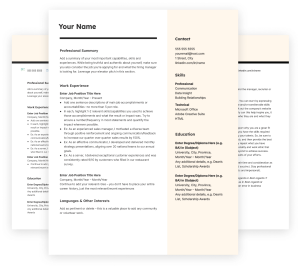For many newcomers, finding employment quickly after moving to Canada is a high-priority action item. Whether you’re contemplating a career switch or looking to get back in your field of work, the first step is usually the same – to have a resume and a cover letter that you can share with potential employers or networking contacts.
In this article, we will explore the Canadian-style resume in detail, highlight some key differences between a resume and a curriculum vitae (CV), and help you identify which resume format might be best suited to your career goal. We will also go over some useful tips to craft an ATS-friendly resume to ensure you stand out from the competition and get noticed by employers, hiring managers, and recruiters.
|
Download our editable, free Canadian resume and cover letter templates to craft the perfect resume for your job search. Whether you’re applying for your first job or showcasing years of experience, these ready-to-use Canadian resume templates will help position you as the ideal candidate. Download templates for:
|
In this article:
What is the difference between a resume and a curriculum vitae (CV)?
Often, there are two ways job seekers can showcase their professional experience to an employer: by using a resume or a CV. In Canada, employers prefer a resume. A CV is mainly used only for academic applications such as academic jobs, grants, research fellowships, etc.
To provide more clarity, here are some key differences between a resume and a CV:
| Resume | CV | |
|---|---|---|
| Length | Very brief – about one or two pages long. | Usually, two pages or longer; no maximum limit on pages. |
| Content | Includes a summary of work experience, education, and skills relevant to the role. | It is very detailed and includes work experience, education, skills, publications, awards, honours, research, affiliations, etc. over the entire course of your career. |
| Purpose | Job applications. | Academic applications. |
Many countries use a CV instead of a resume, and some have a combination of both. Some regions use both terms interchangeably: for instance, in most European countries as well as New Zealand, the term CV is used to describe an equivalent of a Canadian resume. In Australia and South Africa, “curriculum vitae” and “resume” are synonyms that can be used interchangeably. In South Asia, the terms CV and resume are used interchangeably and refer to an equivalent of a traditional CV.
In some parts of the world, it’s common to include personal information such as marital status, nationality, personal interests, hobbies, date of birth, address, and a photograph on a CV. In Canada, however, you shouldn’t include these details on your resume as it is not required under the employment law, and it is also not a part of the resume format.
Understanding the types of resume formats used in Canada
As a job seeker in Canada, there are three types of resume formats you should be familiar with. Each of these formats includes the same basic information in a different layout.
1. Reverse chronological resume
This type of resume outlines your professional experience in reverse chronological order, starting with the most recent position.
When to use a reverse chronological resume?
If you’re an experienced professional with at least some experience in the workforce, have no major employment gaps, and intend to continue working in the same field.
Tip: The reverse chronological resume is the most popular format in the Canadian job market. Most employers and recruiters are used to and prefer a resume in this format.
2. Functional resume
The functional resume focuses on your overall skills and qualifications instead of specific professional experiences. The employment history is still included, but it is usually listed after skills and education.
When to use a functional resume?
If you’re looking to switch roles and/or industries and start your career in a new field. It may also be ideal for recent college graduates.
3. Combination or hybrid resume
A combination resume is a mix of the reverse-chronological layout and the functional layout and is ideal for showcasing transferable skills along with professional experience. In this format, work experience is usually outlined in a reverse chronological format, and the skills section includes a summary of qualifications and technical skills (or core competencies).
When to use a combination or hybrid resume?
It is commonly used by a variety of job seekers ranging from experienced workers to recent graduates to those with limited experience, multiple short-term work stints, or those having significant work gaps.
Need more guidance on how to write a Canadian-style resume?
For a stepwise approach, check out:
Download the free Resume and cover letter templates to craft your Canadian resume
Tips for writing a Canadian-style resume
Mastering the art of writing a flawless and impactful Canadian-style resume takes practice and patience. Here are a few tips to help you improve your resume-writing skills.
1. Adapt your resume to each job listing and keep it relevant
Having a generic resume and sharing it with multiple employers for a variety of positions/roles may not yield the best result for you. It is essential to customize your resume to each position that you’re applying for. Tailor your work experience, skills, and any additional information to the role. Include keywords from the job posting and always start your sentence with relevant action verbs like spearheaded, achieved, managed, trained, etc. Craft a compelling summary for your resume. Avoid including very detailed information for each position you have held; you can share relevant details in the interview instead.
Job interview resources:
2. Optimize for Applicant Tracking System (ATS) but write for humans
Many companies use an ATS to pre-screen resumes and then involve recruiters and hiring managers later in the process. You need to keep both in mind when writing your resume.
What is an ATS?
An ATS is a software that scans resumes to determine if it is a good match for a specific job listing. Parameters such as work experience, skills, and education are usually considered during the ATS screening process. Resumes that match the pre-defined criteria are forwarded to hiring managers or recruiters, while human eyes never see those rejected by the system. Therefore, even though you may be qualified for the position, if your resume isn’t optimized for an ATS, it may end up being rejected. An ATS is widely used by organizations, recruiters, and job placement agencies in Canada.
How to optimize a resume for ATS
- Use standard formatting and don’t include images, designs, charts, and tables.
- Use correct headers and include keywords that match the job description and desired core competencies and skills.
- Send your resume as a Microsoft Word (.doc or .docx) document. Most ATS systems tend to process Word files better than PDF.
- Spell out abbreviations at least once on your resume.
- Include experience, skills, and qualifications relevant to the position.
- Avoid long paragraphs and font size less than size 10.
- Convert technical terms, grades, and scores to their Canadian equivalents.
3. Check spelling, grammar, punctuation, and proofread your resume
It’s always a good idea to proofread your resume and check grammar, spelling, punctuation, and sentence formation, especially if English isn’t your first language or mother tongue. There are many free tools that can help you with proofreading: Grammarly as well as the in-built grammar and spelling tool in Microsoft Word, are good starting points. You can also ask a native English speaker to review your resume for language fluency.
To help you finesse your English language skills and get more tips and advice from an experienced teacher, Karen Thomson, read How to improve your English and adapt to Canadian culture.
4. Quantify your accomplishments
Many job seekers make the mistake of outlining roles and responsibilities instead of achievements. Recruiters and hiring managers prefer seeing quantified accomplishments on resumes. The ‘CAR’ approach is a good way to help you structure individual sentences:
C = what was the Challenge,
A = what Action did you take, and
R = what was the Result.
Some examples to consider:
- “Reached eBay Power Seller status within one year by auctioning over 400 items per month, an exceptional accomplishment reached by only 4 per cent of the 29 million eBay sellers at that time.”
- “Designed and built statistical analysis models on large data sets (e.g. Aster, Teradata) that helped increase online sales (up to 15 per cent per product) and lowered cart-abandonment rate by 23 per cent.”
5. Include a cover letter
A cover letter is a formal one-page document that accompanies a resume. It is not a rephrased or concise version of your resume, but it is mainly supposed to talk about how you fit the role you’re applying for and why the organization should hire you. The cover letter is also a good way to justify any gaps in your resume or provide any additional info that your resume can’t.
Note that a cover letter doesn’t have to be a separate document but can also be included in the body of an email when applying for a job. Adding a custom, well-written cover letter to your resume can make you stand out from the crowd, thus improving your chances of being approached for an interview.
Tips for writing an impressive Canadian-style cover letter
- Limit the length to one page.
- Tailor your cover letter to suit each job application.
- Proofread your cover letter; check for grammar, punctuation, and spelling, especially since it serves as a reflection of your communication skills.
- Use a standard font size (10 or 12 points, in a font style such as Times New Roman, Arial, or Calibri). Avoid using special effects (bold/underline/italics, different fonts, and colour).
- Weave in information you know about the company, their recent projects, or organizational culture and values.
Looking for more guidance on cover letters?
Read How to write an effective cover letter for advice and insights from recruiters.
6. Show off your skills with unpaid or local volunteer work
This is a good way for newcomers to show Canadian experience on their resume. If your volunteer work requires you to use skills that may also be valued in the position that you are applying for, adding the volunteer experience to your resume may work to your advantage.
Tip: Volunteering can help you build your network and earn Canadian experience. To discover the importance of volunteering in Canada, and learn how to find volunteering opportunities, read The benefits of volunteering as a newcomer in Canada.
7. Double check your contact information
Newcomers sometimes have temporary phone numbers and addresses during their initial months in Canada and occasionally forget to update their contact when they get a permanent one. Before submitting your resume to an employer or a recruiter, do check all your contact information, including social media links, to ensure they are up-to-date.
Tip: LinkedIn is extensively used in Canada by recruiters and job seekers, making it an excellent tool to get started on your job search journey. Read Top 10 tips to optimize your LinkedIn profile for a job search in Canada for easy-to-follow advice to optimize your LinkedIn profile and build your professional network strategically.
|
Navigating the Canadian job market can be overwhelming. Arrive guides on Finding Your Career in Canada and the Canadian Job Market explain all the need-to-know information and action items you can take to prepare yourself for finding and landing a job opportunity in Canada. Download your copies now and fast-track your professional success! |
A well-crafted resume and cover letter are strong marketing tools to help you get the job you desire. Being familiar with the best practices and employer expectations in Canada will better your chances of securing an interview and landing an offer.
читайте це українською: Резюме та супровідний лист за канадськими правилами: формат, поради та шаблони
این را به فارسی بخوانید: رزومه و معرفی نامه در کانادا: فارمت، نکات و قالب ها







